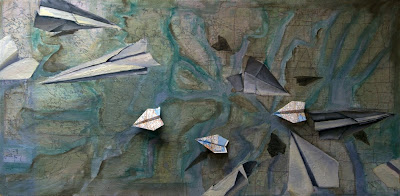 Pythagorean Theorem I: The Set Up
Pythagorean Theorem I: The Set UpOil, mylar, nails, fishing line, and wire on board
11" x 11"
2008
$150
 Pythagorean Theorem II: First Steps
Pythagorean Theorem II: First StepsOil, mylar, nails, fishing line, and wire on board
11" x 11"
2008
$150
 Pythagorean Theorem III: Shadow of My Former Self
Pythagorean Theorem III: Shadow of My Former SelfOil, mylar, nails, fishing line, and wire on board
11" x 11"
2008
$150
 Pythagorean Theorem IV: Self Aware
Pythagorean Theorem IV: Self AwareOil, mylar, nails, fishing line, and wire on board
11" x 11"
2008
$150
The Pythagorean Theorem Series shows the geometric proof of the Pythagorean Theorem (
a^2 +
b^2 =
c^2) in eight steps. The proof begins with two squares; one has sides of length
a and the other has sides of length
b. These two squares have areas of
a^2 and
b^2, respectively, and the proof essentially manipulates these areas until we see that when they are combined, they equal the area of a third square with sides of length
c and area
c^2. The proof manipulates the areas of the squares by cutting them into triangles, so you'll see triangles in most of the works. Circles are also visible to show the equality or inequality of certain lengths. The coordinate axes appear so that viewers can orient the shapes, and other geometric shapes that I found important to the proof are painted in high gloss.
To me, the way that the proof maneuvered the areas of the triangles seemed to relate to cross culturalism- the triangles looked different, they interacted differently, but they essentially were all triangles of the same area (area as a basic element of their identity, and area as in the space that they live). Furthermore, after being translated (in a non-mathematical sense) all over the place, they achieved unity and accomplished a profound goal! It's a pretty cheesy personification, but the analogy inspired me...
I related the two ideas by illustrating each step of the proof with a stage of life that seems fairly universal. The first stage is being a fragile infant, the second is as a young child gaining independence, third is realization of growth and impending maturity, fourth is the self aware feeling that comes with the physical ability to reproduce, fifth is "striking out to seek your fortune" or to have a role in society, sixth is the desire to find others similar to yourself and to bond with them, seventh is to forge loving relationships, and last is to restart the cycle. (The last four images will be in next week's post!) The title of each piece refers to the life stage that is illustrated as well as to the actual movement of the triangles in the proof. For example, in
Shadow of My Former Self, the triangles have been elongated so that they look like shadows of the two original triangles, but the title also refers to the feeling of having left one's childhood.





























